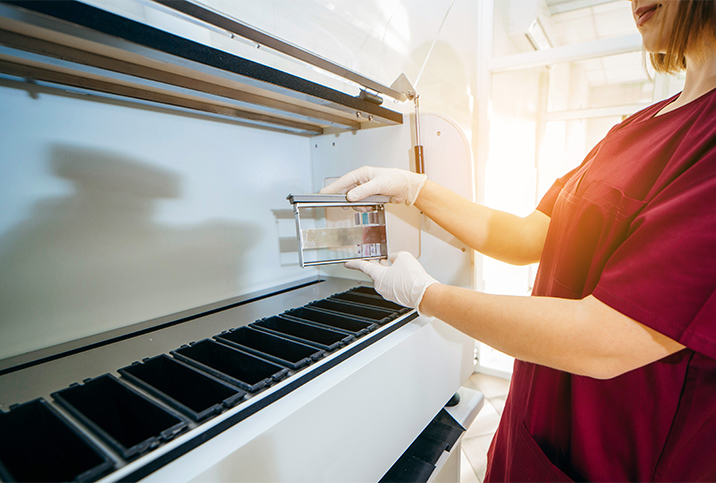The Facts About Breast Cancer

Breast cancer is an uncontrolled growth of abnormal cells in the breast, most often originating in breast endothelial tissues—lobules (milk-producing glands) or ducts (passages that drain milk from the lobules to the nipple)—though it can also originate from breast stromal tissue.
There are multiple types that grow at different rates and have different treatment plans, prognoses and outcomes, but when it is detected early, breast cancer typically has excellent outcomes.
Demographics
Breast cancer is the number two cancer, after skin cancer, affecting women in the United States: 1 in 8 women will be diagnosed with it in their lifetime. Their risk increases with age, as women 50 and older are significantly more likely to develop it. It's more common before menopause in African American women than in white women.
Breast cancer in men is possible, but women are at much higher risk, comprising more than 99 percent of cases. It is estimated that at least 3.8 million women in the U.S. have currently been diagnosed.
Risk factors
Family history plays a significant role in your risk of being diagnosed with breast cancer, especially if you have a first-degree relative (mother, sister, daughter) diagnosed with the disease. That doubles a woman's risk. Some of the other most important factors to take into account include the following:
- Hormone history (e.g., taking combined hormone replacement therapy, or HRT)
- Menstruating before age 11
- Beginning menopause before age 55
- Not experiencing a full-term pregnancy before age 30
Recent research points to mutations in two genes, Breast Cancer Gene 1 and Breast Cancer Gene 2—also known as BRCA1 and BRCA2—as a cause for concern.
Everyone has these genes, and their job is to oversee cells in the breast and ovaries to make sure they're functioning as they should and to manage the repair of cells where necessary. The problem occurs when these genes mutate, and those mutations are passed down from mothers to their babies.
It's estimated that as many as 10 percent of breast cancer cases are related to inherited BRCA1 and BRCA2 mutations.
History of a premalignant breast biopsy, chest-wall radiation or radiation treatment for Hodgkin lymphoma prior to age 40 also increase risk.
Another issue has to do with dense breast tissue. A 2011 study from Harvard Medical School and Brigham and Women's Hospital in Boston reported women with more than 50 percent breast density were three times as likely to be diagnosed with breast cancer over 15 years than women with less than 10 percent breast density.
This is due, in part, to the masking effect—dense breast tissue makes it more difficult to detect a mass through mammography—though the transition to digital mammography in recent years has improved detection in dense breasts. However, other studies indicate dense breasts may increase the risk for more aggressive forms of breast cancer, independent of the masking effect.
Finally, environmental and lifestyle factors can play a key role in a breast cancer diagnosis.
Environmental issues include exposure to pesticides, harmful chemicals, radiation, and environmental and dietary estrogens. Lifestyle factors that can have an impact include alcohol use (two to five drinks daily increases the risk of cancer by up to 1.5 times), smoking, being overweight, physical inactivity and poor diet.
Regardless of all of these possible factors, 7 in 10 women diagnosed with breast cancer have no apparent risk factors beyond being female and of increased age.
Symptoms
The symptoms of breast cancer may include an unfamiliar lump in the breast, a thickening or hardened spot, or changes in the size or shape of the breast, including asymmetry. There may also be a physical change in the breasts' appearance, such as redness; pitting or dimpling of the skin; inversion of the nipple; bloody or clear discharge from the nipple; skin changes including peeling, scaling, crusting or flaking; and breast or nipple pain.
Further symptoms that might indicate the cancer is spreading from the breasts to other parts of your body include:
- Shortness of breath
- Chest pain
- Persistent bone or joint pain
- Unexplained weight loss
- Jaundice
- Hypercalcemia symptoms
- Localized neurological signs
- Abdominal distension
- Headaches
- Confusion and altered cognitive function
- Vision changes
Clinical signs more noticeable to a professional healthcare provider include swollen lymph nodes under the armpit or around the collarbone, dilated veins, ulceration, and swelling of all or parts of the breast.
Diagnosis
Up to a quarter of all breast cancers are detected through a self-exam, and a significant portion are caught during normal mammogram screening—the first-line screening method for all women. (Many health experts and organizations are dropping breast self-exams from their protocols, and even more are emphasizing that self-exams are an adjunct to, not a substitute for, mammography.)
Currently, the American Cancer Society recommends a mammogram yearly for women ages 45 to 54; women 55 and older can continue with annual mammograms or switch to every two years. Other organizations have different guidelines. Women with any of the high-risk factors for breast cancer are typically recommended to begin mammograms earlier.
The effectiveness of a mammogram varies significantly, with masses in higher-density breasts much more difficult to detect. In these cases, an ultrasound or an MRI (magnetic resonance imaging) may be recommended. These procedures are more likely to find noncancerous lesions and result in more invasive testing, so their use is generally limited to high-risk patients only.
If a mass is detected, the patient is referred for a biopsy, which excises a small tissue sample for analysis. There are multiple types of breast biopsies, and the biopsy sample can be tested for various indicators. A biopsy is the only definitive way to diagnose breast cancer, because it identifies the type of cells involved in the tumor and their critical characteristics. Doctors use the data to inform the next steps.
Stages
A breast cancer diagnosis comes with terminology that can be confusing, at least at first, as each case is given a cancer grade and a stage.
A cancer grade—a number from 1 through 3—is determined by a pathologist based on how abnormal a cell looks under a microscope, and that number will provide insight into how quickly it is likely to grow and spread. Less abnormal, slower-growing cells are scored a 1, and very abnormal, fast-growing cells are denoted as a 3.
However, grade alone doesn't indicate prognosis. A grade 3 is not a death sentence; outcomes can be excellent if cancer is detected early. Similarly, a grade 1 doesn't necessarily indicate a good prognosis. How far along the cancer is at the time of diagnosis plays a significant role, and this is indicated by the stage of cancer.
Cancer stages are based on tumor size and extent, whether cancer appears in the lymph nodes, and if so, how many, and how much the cancer has spread to other parts of the body—how much it has metastasized, to use the correct medical terminology. Stage typically plays a more important role than grade in determining treatment recommendations.
Stages range from 0 through IV and include individual markers 0, IA, IB, IIA, IIB, IIIA, IIIB, IIIC and IV. Here's what they mean:
- Stage 0 indicates no presence of a tumor. Carcinoma in situ is a very early form of cancer, between stages 0 and I, that may be ductal or lobular.
- Stage I is split into IA and IB, where IA is smaller and indicates that the cancer has not spread to any lymph nodes.
- In Stage II, broken into A and B, IIA is typically smaller and in only one to three lymph nodes. Stage IIB indicates that the tumor is larger and/or has spread to more lymph nodes.
- Stage III is more advanced but has not spread to other organs—bones, lungs, brain, liver are the most likely places—with the markers A to C indicating a progressively larger tumor or increased spread to lymph nodes.
- Stage IV indicates cancer that has metastasized.
Treatment options
Treatments vary considerably based on the patient, the grade and particularly the stage of their cancer. The majority of women undergo some type of surgery:
- Lumpectomy is the removal of cancerous breast tissue and a margin of healthy tissue while conserving the breast.
- Mastectomy is the removal of all breast tissue from one breast.
- Double mastectomy is the removal of all breast tissue from both breasts.
Lymph nodes may also be surgically removed. Patients may elect to have breast reconstruction after surgery.
Follow-up treatment with radiation therapy is common, using high-energy beams to kill cancer cells after a lumpectomy or in the chest wall after a mastectomy. Radiation treatments can last from several days to six weeks, with side effects including fatigue and a sunburn-like rash.
Chemotherapy is another common treatment that uses drugs to target rapidly dividing cancer cells. Chemo's side effects can be challenging, including nausea, vomiting, weight loss, hair loss and fatigue. Hormone therapies are common for hormone-sensitive breast cancers, as well as other targeted drugs such as those that produce the HER2 protein.
Immunotherapies may be an option for women with triple-negative breast cancer (TNBC), using their own immune system to fight cancer cells. Palliative care can help reduce pain and other difficult symptoms.
Stage 0 and ductal carcinoma in situ (DCIS) breast cancers are typically treated with breast-conserving surgery (BCS), or partial mastectomy. In general, stages I through III will be treated by surgery and radiation. Chemotherapy and other drugs are commonly used after surgery, or before it in cases of a large tumor. Stage IV breast cancer is most often treated with systemic drug therapy—hormone therapies, chemotherapy, targeted drugs, immunotherapy or a combination—though surgery and radiation are occasionally used, as well.
The oncology team helps determine which therapy or combination of therapies is right for the patient.
Outlook and recovery
Survival rates are one indicator of prognosis. For breast cancer, the SEER (Surveillance, Epidemiology and End Results) database determines five-year relative survival rates based on the spread of cancer. A relative survival rate compares women with the same type and stage of breast cancer to women in the overall population.
Based on women diagnosed from 2010 to 2016, localized breast cancers—with no sign of having spread beyond the breast—have an outstanding relative survival rate of 99 percent. This means that women who have this type of cancer are, on average, about 99 percent as likely as women who don't have this cancer to live for at least five years after being diagnosed.
Regional cancers, which spread to nearby structures or lymph nodes, have a five-year relative survival rate of an encouraging 86 percent, but for distant cancers that have spread throughout the body to bone, lungs or brain, the relative survival rate drops to 28 percent.
Looking at all the breast cancer stages combined, the overall prognosis is a 90 percent five-year relative survival rate.
The prognosis for breast cancer has improved significantly over the years, with fewer and fewer fatalities thanks to improved screening and detection methods, more advanced treatment options and greater awareness of prevention strategies. And it's likely that survival rates may be even higher than SEER numbers suggest, as these are based on five- to 10-year-old cases, and medicine has made significant advancements in that short time.
Also, if you're reading these rates and comparing them to your own case or someone you love, please be aware that these statistics do not take into account other factors—overall health, age, tumor grade, HER2 status, hormone receptor presence and response to treatment—so they may not perfectly reflect any one individual's likelihood of survival, but rather an average. For example, SEER rates do not apply to women with triple-negative or inflammatory breast cancer.
Rate of recurrence
Recurrent breast cancer is cancer that returns months or even years after initial treatment was carried out with a successful result. Generally, this occurs when any breast cancer cells from the original cancer diagnosis manage to survive the initial treatment, slowly grow over time and create a new tumor.
Recurrence, which can be local, regional or distant, can be an emotionally difficult diagnosis for someone who has already fought off breast cancer once. Rates of recurrence depend on the individual, the type of breast cancer, and the stage and grade. The risk of recurrence is higher in women whose original cancer included lymph-node involvement, larger tumor size and close tumor margins. Risk also increases for women who are obese, are younger, had inflammatory breast cancer, or didn't receive radiation treatment after a lumpectomy or endocrine therapy after hormone receptor-positive breast cancer.
Women can minimize their chance of breast cancer recurrence through a number of strategies: chemotherapy, radiation therapy, hormone therapy after treatment, targeted therapies, bone-building drugs and lifestyle modifications.
Appropriate follow-up care—or to use the correct medical terminology, a survivorship care plan—is also essential. The plan coordinates subsequent exams and tests and provides tips to keep healthy. Doctor visits should be scheduled every few months after treatment finishes and eventually move to annual checkups. Women who didn't undergo a double mastectomy should follow mammogram recommendations, which are typically every six to 12 months after surgery or radiation. Additional tests, including bone density and blood tests and other imaging, may also be recommended.
Can breast cancer be prevented?
While breast cancer is unnervingly common, mortality rates dropped 1 percent each year from 2013 to 2018, likely thanks to improved screening, detection and treatment. Additionally, lifestyle and environmental risk factors are being reduced as people at risk for breast cancer begin to make changes to their daily routine, such as eating a healthy diet and maintaining a good weight, engaging in physical activity, abstaining from smoking, minimizing their consumption of alcohol, and avoiding exposure to toxic chemicals. Breastfeeding may also reduce a mother's risk, and limiting hormonal therapies after menopause can help older women.
Some high-risk women, such as those with mutations of the BRCA gene in their immediate family history, opt to undergo prophylactic, or preventive, mastectomy. There are also three medications—raloxifene, tamoxifen and aromatase inhibitors—currently being used as pharmacologic prevention. These treatments have been shown to reduce the risk of hormone-responsive breast cancer in this demographic by as much as 50 to 60 percent.
Resources
If you notice any suspicious signs or symptoms that might indicate breast cancer, schedule an appointment with a doctor immediately for a mammogram and additional imaging, as needed.
Don't put off seeing your doctor; every day counts when cancer is involved. And if you are diagnosed, start reaching out for as much information as you can find and start building a support group to help you get through this situation.
An estimated 340,000 women will be diagnosed in 2021, so you will find others who are in exactly the same position as you are. There are some wonderful resources on the internet that can provide not only the kind of in-depth information you're looking for but also deliver that vital connection between you and others in your same situation.
The websites at National Breast Cancer Foundation, Susan G. Komen and Cleveland Clinic are all excellent resources, and remember, as you're reading, to start compiling a list of questions for your doctor on your next visit. Don't allow fear of the unknown to be a problem; start loading up on as much information as you can. And even if you can't remember it all, bookmark every site that's useful, so you have quick access to unanswered questions.
Consider joining a breast cancer support group for emotional comfort as well as practical advice.
An especially important step is to open up to family, friends and a partner. They'll want to be there for you on this journey, and allowing them to share the load will make it easier for both you and them. Show them the internet links you've found, tell them what the doctors have told you and allow them to become as involved in your life as you're comfortable with during this difficult time.
If you're struggling, speak up and get help. Consider talking to a therapist who can help you work through your diagnosis and cope with the situation. Explore self-care. Make time to do tasks and activities for yourself, and even pursue some new stress-relieving practices such as gardening, cycling, painting or meditating.
Breast cancer significantly impacts the lives of millions of American women, but the vast majority survive and live long, fulfilling lives. Knowing how to protect yourself and the signs to look for can maximize your odds of a good outcome.


















